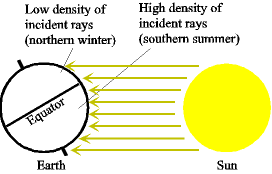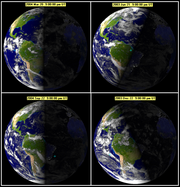Season
|
|
A season is one of the major divisions of the year, generally based on broad climatic patterns. For temperate regions, the year is typically divided into four seasons: spring, summer, autumn (fall), and winter.
Some cultures may have a different number of seasons; for instance, some indigenous peoples in Australia's Northern Territory use six seasons. In tropical and even subtropical regions it is more common to speak of the rainy (or wet, or monsoon) season versus the dry season, as the amount of precipitation may vary more dramatically than the average temperature. Ancient Egypt divided the year into three seasons, the season of the flood, the season of emergence from the flood, and the hot harvest season.
There are also other types of "seasons" based upon climatic conditions. For example, the Tornado Alley area of the United States has its Tornado season (peaking from late winter through mid summer, depending upon latitude). Areas with a Mediterranean climate, such as Western Australia, coastal California, and Spain have their summer Fire season. Hurricane season begins in late spring, on 15 May in the northeastern Pacific and 1 June in the northern Atlantic.
| Contents |
Causes and climatic effects
| Fig. 1 This is a diagram of the seasons. Note that, regardless of the time of day (i.e. the Earth's rotation on its axis), the North Pole will be dark, and the South Pole will be illuminated; see also arctic winter. In addition to the density of incident light, the dissipation of light in the atmosphere is greater when it falls at a shallow angle. |
| Fig. 2 Missing image |
The primary cause of the seasons is the fact that the Earth's axis is not perpendicular to its orbital plane; it deviates by an angle of approximately 23.5 degrees of arc. Thus, at any given time during the summer or winter, one part of the planet is more directly exposed to the rays of the Sun (see Fig. 1). This exposure alternates as the Earth revolves in its orbit. At any given time, regardless of season, the northern and southern hemispheres experience opposite seasons (see Fig. 2 and Month ranges of seasons (below)).
Seasonal weather fluctuations also depend on factors such as proximity to oceans or other large bodies of water, currents in those oceans, [[El Ni/ENSO and other oceanic cycles, and prevailing winds.
In the temperate and polar regions, seasons are marked by changes in the amount of sunlight, which in turn often cause cycles of dormancy in plants and hibernation in animals. These effects vary with latitude, and with proximity to bodies of water. For example, the South Pole is in the middle of the continent of Antarctica, and therefore a considerable distance from the moderating influence of the southern oceans. The North Pole is in the Arctic Ocean, and thus its temperature extremes are buffered by the presence of all that water. The result is that the South Pole is consistently colder during the southern winter than the North Pole during the northern winter.
The cycle of seasons in the polar and temperate zones of one hemisphere is opposite to that in the other. When it is summer in the Northern hemisphere, it is winter in the Southern hemisphere, and vice versa, and when it is spring in the Northern hemisphere it is autumn in the Southern hemisphere, and vice versa.
In the tropics, there is no noticeable change in the amount of sunlight. However, many regions (famously the northern Indian Ocean) are subject to monsoons rain and wind cycles.
Curiously, a study of temperature records over the past 300 years (David Thompson, SCIENCE, April 1995) shows that the climatic seasons, and thus the seasonal year, are governed by the anomalistic year rather than the tropical year.
Polar day and night
A common misconception is that, within the Arctic and Antarctic Circles, the sun rises once in the spring and sets once in the fall; thus, the day and night are erroneously thought to last uninterrupted for 183 calendar days each. This is true only in the immediate region of the poles themselves.
What does happen is that any point north of the Arctic (or south of the Antarctic) Circle will have one period in the summer when the sun does not set, and one period in the winter when the sun does not rise. At progressively higher latitudes, the periods of "midnight sun" (or "midday dark" for the other side of the globe) are progressively longer. For example, at the military and weather station called Alert on the northern tip of Ellesmere Island, Canada (about 450 nautical miles or 830 km from the North Pole), the sun begins to peek above the horizon in mid-February and each day it climbs a bit higher, and stays up a bit longer; by 21 March, the sun is up for 12 hours. However, mid-February is not first light. The sky (as seen from Alert) has been showing twilight, or at least a pre-dawn glow on the horizon, for increasing hours each day, for more than a month before that first sliver of sun appears.
In the weeks surrounding 21 June, the sun is at its highest, and it appears to circle the sky without ever going below the horizon. Eventually, it does go below the horizon, for progressively longer and longer periods each day until, around the middle of October, it disappears for the last time. For a few more weeks, "day" is marked by decreasing periods of twilight. Eventually, for the weeks surrounding 21 December, nothing breaks the darkness. In later winter, the first faint wash of light briefly touches the horizon (for just minutes per day), and then increases in duration and pre-dawn brightness each day until sunrise in February.
Reckoning
The date at which each season begins depends on how it is defined.
In the United States, the seasons are often considered to begin at the astronomical solstices and equinoxes: these are sometimes known as the "astronomical seasons". By this reckoning, summer begins at summer solstice, winter at winter solstice, spring at the vernal equinox and autumn at the autumnal equinox.
In the United Kingdom, the seasons are traditionally considered to begin about seven weeks earlier: spring begins on Candlemas, summer on May Day, autumn on Lammas, and winter on All Hallows.
The Irish calendar uses almost the same reckoning; Spring begins on February 1 / Imbolc, Summer on May 1 / Beltane, Autumn on August 1 / Lughnasadh and Winter on November 1 / Samhain.
In meteorology for the Northern hemisphere, spring begins by convention on March 1, summer on June 1, autumn on September 1 and winter on December 1. This definition is also followed in Denmark.
Conversely, for the Southern hemisphere, meterological summer begins on December 1, autumn on March 1, winter on June 1 and spring on September 1. This definition is also followed in Australia.
In the Korean, Chinese, and Japanese calendars are based on a lunisolar calendar where the seasons are defined so that the solstices and equinoxes occur in the middle of each season, which is very close to the meteorological definition of seasons.
| Northern Hemisphere | Month | Southern Hemisphere | |||
|---|---|---|---|---|---|
| Traditional | Meteorological | Astronomical | Meteorological | Astronomical | |
| Winter | Winter | Winter | January | Summer | Summer |
| Spring | February | ||||
| Spring | March | Autumn | |||
| Spring | April | Autumn | |||
| Summer | May | ||||
| Summer | June | Winter | |||
| Summer | July | Winter | |||
| Autumn | August | ||||
| Autumn | September | Spring | |||
| Autumn | October | Spring | |||
| Winter | November | ||||
| Winter | December | Summer | |||
Mid-season
In the conventional American calendar, the following dates are considered to be halfway through a season:
- Winter (February 3)
- Spring (May 5 or May 6)
- Summer (August 7)
- Fall (November 6)
External links
- The seasons begin at the time of the solstice or equinox (http://www.badastronomy.com/bad/misc/badseasons.html) (from the Bad Astronomer)
- Solstice does not signal season's start? (http://www.straightdope.com/classics/a1_170b.html) (from The Straight Dope)


